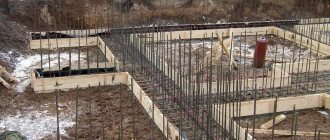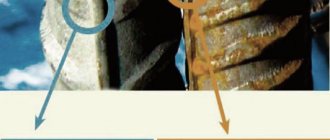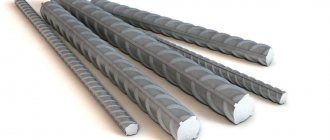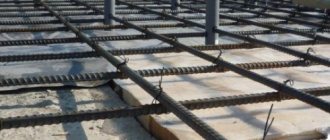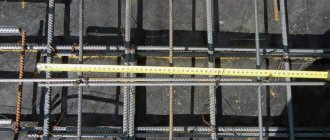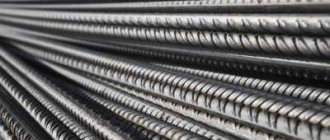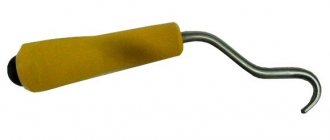A reinforcement cage must be present in any load-bearing reinforced concrete structure, be it a grillage, foundation, floor slab or column. To give it a rigid spatial form, a strong connection of all intersection nodes is necessary. This is done by welding or tying with a special wire, flexible and durable. It is difficult to tighten the wire by hand, so they use a hook for tying reinforcement, with which the work is done much faster and with better quality.
There are many intersections in the frame, so the speed of their knitting is very important Source sdelaipotolok.com
Advantages of knitting over welding
When installing a screed, pouring a blind area and other thin layers of concrete, a spatial frame is not made, filling one layer of reinforcing mesh or steel rods with the solution. When pouring massive structures designed for load, a load-bearing “skeleton” is made for them, uniformly reinforcing the entire volume of concrete. It will be able to effectively perform its functions only on the condition that it itself is strong and rigid, for which purpose all intersections are connected.
Theoretically, welding provides a stronger connection, but professionals do not recommend using this method. And the point is not only that a crochet hook for reinforcement is much cheaper and more accessible than a welding machine, and it’s easier to master working with it. Welded joints have other disadvantages.
- When welding, the metal heats up greatly, internal bonds are broken, and it becomes less durable.
- At joints connected by welding, corrosion occurs more often and faster, so the service life of such a frame is lower.
Welded frame for bored piles Source profstroy58.ru
In addition, welding can only be done in dry weather; this is a safety requirement, non-compliance with which can have very unpleasant consequences.
Connecting with wire does not have all these disadvantages, and anyone can master the tool for tying reinforcement.
Automatic hook for tying reinforcement
A special device with a reverse operating principle allows you to speed up and automate the twisting process. At first glance, it looks like a standard manual device, but differs in the presence of a screw mechanism consisting of the following parts:
- plastic handle with internal screw thread;
- working body with a screw thread on the rod.
When assembled, these elements form a mechanism with a reciprocating principle of operation. The reversible device works quite simply - moving the handle causes rotation of the working element on which the wire loop is put.
Advantages of the reversible device:
- increased wire binding performance;
- Possibility of use in areas with limited access;
Automatic hook for tying reinforcement
- ease of knitting operations;
- durability of the device with regular lubrication.
The device has the only drawback - its increased price when compared with the cost of a conventional hand tool.
Using a reversible tool, the knitter can perform an increased amount of work without getting tired. The screw device is superior in efficiency to the manual device when it is necessary to manually pull and twist the wire ends. Without reinstalling the working hook, by cyclically moving the handle you can achieve reliable fastening.
Procedure for using the device:
- Insert the hook of the tool into the twisted loop.
- Pull the handle towards you along the working axis.
- Return the handle to the starting position.
- Perform the next movement cycle.
You can also make your own semi-automatic tightening device using a regular screwdriver. You will need a bent nail without a head or an L-shaped rod, the end of which must be inserted into the tool chuck. With a little practice, it is not difficult to master the principles of operation using this device.
Types of hooks for fittings
There are different types of hooks on sale - manual, mechanical, automatic. Many people make manual types and various devices for tying reinforcement using electric or battery-powered tools with their own hands “for themselves.” The fact is that finished products are not always of good quality and can be inconvenient, so some builders prefer homemade hand tools with a handle adjusted to the hand and the desired bend of the hook.
Homemade hook from a piece of reinforcement Source mirbetona.info
See also: Catalog of companies that specialize in designing country houses
Hand hook
The hand tool is a specially curved hook that rotates freely in the handle. It is the most inexpensive of all, the price ranges from 100 to 300 rubles and depends on the manufacturer, the quality of the steel and the material of the handle.
Advice! For constant use, it is better to choose a crochet hook with a wooden or plastic handle. Metal, as in the first photo, is inconvenient to work in winter.
The maximum speed of crocheting with this type of crochet is 10-15 knots per minute. If the volume of the frame is small or you have a one-time job to do, for example, reinforcing the foundation for a house, this tool will do its job perfectly.
Algorithm for crocheting joints by hand:
- the wire is cut into pieces 25-30 cm long (it is better to cut the entire coil at once with a grinder);
- fold the segment in half;
- the resulting loop is slipped under the crosshairs of the reinforcement and bent upward;
- thread the hook into the loop;
- the free ends of the wire are also lifted and bent onto the hook;
- Having made several rotations, tighten the knot and remove the hook for the reinforcement from the loop.
DIY crochet hook
Often, factory-made crochet hooks do not fully satisfy the needs of builders performing reinforcement. This is because their rods may have an incorrect bend.
It happens that the length of the working surface is too short and does not allow making a knot in a hard-to-reach place. In such cases, a homemade crochet hook is twisted.
We make the right construction hook with our own hands. Materials
To make hooks, specialists use electrodes for welding machines, or less often, a piece of steel wire at least 4 mm thick.
There is no need to create drawings; you only need the following materials:
- - trowel handle, piece of hose or roller handle
- - electrode or 4 mm wire
- - sharpener
Process
- We make a handle from the hose for the future hook, or use the handle from a trowel/roller.
- We insert the rod (electrode or wire) into the hole in the handle or into a piece of hose and fix it with epoxy resin.
- After the epoxy has dried, bend the rod 90 degrees at a distance of 5 cm from the handle. The correct bend resembles a rocker arm.
- We bend the end of the rod in an arcuate manner.
- We sharpen the sharp part of the electrode with a sharpener or a file.
HELPFUL HINT: If instead of a handle you attach the end of a homemade hook to a screwdriver, then you will get a semi-automatic hook made by yourself
Crochet reinforcement. Technology
The process of knitting reinforcement for constructing a foundation, flight of stairs or screed differs only in the type of crochet hook. The technology of knot twisting itself does not change. It is usually recommended to immediately cut the steel wire into pieces of 30-40 cm. Experienced craftsmen first make several test knots to clearly see how long a piece of wire is required. This way the wire consumption will be minimal.
HELPFUL ADVICE: If you come across heavy bending wire, you can warm it up over a fire for 30 minutes, let it cool, and then get to work.
Stages of tying reinforcement
- — cutting steel wire for workpieces
- - folding the workpiece in half and turning it around the intersection of the rods
- - gripping the ends of the wire with a hook through the loop of the workpiece
- — 2-3 rotational movements to obtain a knot
- - neat crochet twist tightening
- — checking the assembly (we move the reinforcement bars - they should fit tightly to each other)
The whole process is very simple. But before you try, it’s better to study photos of the creation of reinforcing structures.
Briefly about the main thing
Whether to buy or make a hook for tying reinforcement yourself is up to the person who will use it. If you need to make only a few dozen knots, you can get by with a homemade hook, bent from a sharpened and cleaned electrode. It is more convenient to assemble a frame for a foundation or other large important structure with a mechanical rotating hook, which can also be made in the form of an attachment for a screwdriver. And an automatic pistol is too expensive equipment to consider for use in private construction.
Work specifics
Externally, the instrument is a fairly compact device that weighs a little more than 4 kg.
The main components of the pistol are:
- Case with mechanism.
- Cutting mechanism.
- Handle with start button.
- Wire feed mechanism.
- Working part.
- Electric drive device
- Reel holder.
- Wire cassette.
Expert opinion
Torsunov Pavel Maksimovich
The specific operation of the knitting device is quite simple: wire is fed from a reel, a loop is formed at the intersection of the reinforcing bars, tightened, and then the wire is automatically cut off.
Top best models
Firecore, 12 V, 1500 mAh
- Plus: high binding speed.
- Cons : none found.
Grost RT 308 C
- Plus: easy knitting of reinforcement.
- Cons: none found.
Egor: “Before using a new coil from the components, I sand it down. After this, the feed goes smoothly, the reel does not bite.”
Firecore, 12 V, 3000 mAh
- Plus: 2 batteries included.
- Cons: Not found.
Tips for using a knitting gun
Buying or renting this tool is expensive, and in order not to waste money, you need to follow the operating rules.
In the case of this device it is:
- Full charge of the battery, compliance of the wire and reinforcing bars with the parameters and “original” components. It is recommended to be especially careful when using components from Japanese brands; such a tool can easily be broken by using, for example, Chinese wire. Plus, such a breakdown is not included in the warranty agreement.
- It is also recommended to use extensions to form grating units if work is carried out with large horizontal frames. This will make the work much easier.
- Even though the operator can do more work with a knitting gun, an assistant is still needed.
What gun do you use for tying reinforcement?
BatteryMechanical
Why should you choose such a device?
A professional tool is the key to a high-quality result that will last for many years.
The main advantages of using a knitting gun are:
- High quality wire knots.
- Operative pace of work.
- Easy replacement of wire cassettes.
- Scope of work – 1 person can do the work for a small team.
- Fairly light weight.
- Possibility of knitting multi-layer knots.
- Adjusting the stretch marks makes the frame more durable.
- Pull tightly.
- Continuity of work during the shift due to a powerful battery.
Expert opinion
Torsunov Pavel Maksimovich
Of course, any tool also has its drawbacks. In particular, for a knitting gun this is a high price, the need to spend money on wire cassettes and inconvenience when working in cramped conditions.
How to choose a good tool?
First you need to decide what type of device is required - mechanical or battery-powered. If the work will be carried out exclusively for household purposes, then users are advised to purchase a mechanical gun, since a battery-powered one will be much more expensive.
Next, we choose which manufacturer is best to purchase the tool from. Builders praise the Japanese, but not everyone can afford the price they ask for their products. German and Korean equipment is considered a little less effective; they cost a little less. The domestic manufacturer also produces knitting guns at a very affordable price.
According to the characteristics, the tool can be divided into three types:
- Universal - work with reinforcement from 4 to 68 mm, wire with a diameter of 1.5 mm is required;
- Guns for binding reinforcement from 4 to 40 mm. They work with wire with a diameter of 0.8 mm and knit in three turns;
- Finally, those that work with reinforcement bars from 4 to 28 mm use the same 0.8 mm wire and make 2-3 turns.
For different types, the price will be appropriate. They will ask for much more for the first than for the third. But you need to approach the choice based on the required amount of work.
Do not buy “non-native” equipment for the equipment. If you have a German pistol, buy only German ones. It’s also not a good idea to manually wind the wire onto a reel - this will make the equipment last much less than it could.


